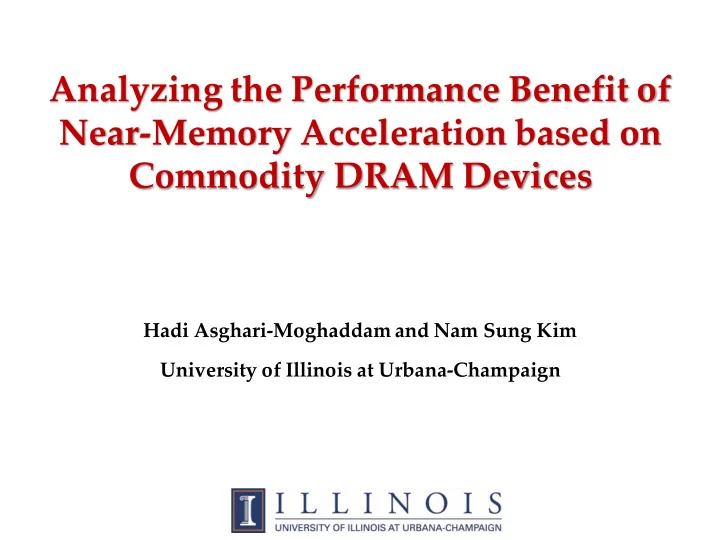

Analyzing the Performance Benefit of Near-Memory Acceleration based on Commodity DRAM Devices Hadi Asghari-Moghaddam and Nam Sung Kim University of Illinois at Urbana-Champaign
2 Why Near-DRAM Acceleration? higher bandwidth demand but stagnant increase ✓ higher data rate and/or wider bus limited by signal integrity package pin constraint http://w ww.maltiel-consulting.com/ISSCC-2013-Memory-trends-FLash-NAND-DRAM.html
3 Why Near-DRAM Acceleration? data transfer energy is more expensive than computation ✓ disparity b/w interconnect and transistor scaling Keckler MICRO’11 Keynote talk: “Life After Dennard and How I Learned to Love the Picojoule ”
4 3D-stacked Near-DRAM Acceleration conventional architectures w/ expensive 3D-stacked DRAM ✓ sacrifice capcity for bandwidth (BW) o one memory module per channel w/ point-to-point connection ✓ insufficient logic die space for accelerators (ACCs) o little space left for ACCs and/or higher BW for ACCs due to large # of TSVs and PHYs ✓ not flexible after integration of ACCs w/ DRAM o custom DRAM module tied w/ specific ACC architecture
5 Background: DDR4 LRDIMM higher capacity for big-data servers ✓ 8 LRDIMM ranks per channel w/o degrading data rate repeaters for data (DQ) and command/address (C/A) signals ✓ a registering clock driver (RCD) chip to repeat C/A signals ✓ data buffer (DB) chip per DRAM device to repeats DQ signals
6 Proposal: In-Buffer Processing 1 built upon our previous near-DRAM acceleration architecture ✓ accelerators (e.g., coarse-grain reconfigurable accelerator (CGRA)) 3D-stacked atop commodity DRAM devices o Farmahini-Farahani, et al. NDA: Near-DRAM acceleration architecture leveraging commodity DRAM devices and standard memory modules, HPCA 2015 processor offloads compute- and data-intensive operations (application kernels) onto CGRAs ✓ CGRAs process data locally in their corresponding DRAM Processor CGRA stacked atop of a DRAM Core Core CGRA L1I L1D L1I L1D TSVs L2 Cache Memory Controller DRAM Device Conventional DRAM Interface DRAM DIMM CGRA-Enabled DRAM Rank
7 Proposal: In-Buffer Processing 2 place near-DRAM accelerators (NDA) in buffer chips ✓ require no change to o processor o processor-DRAM interface o DRAM core circuit and architecture ✓ propose three Chameleon microarchitectures o Chameleon- d , t and - s CMD/ADDR RCD DRAM DRAM DB DB NDA NDA
8 ACC-DRAM Connection: Chameleon-d allocate full DQ bus bandwidth to data transfer b/w ACC and DRAM modules vertically aligned in a LRDIMM ✓ 8-bit data bus b/w ACC and DRAM connect C/A pins to the RCD through BCOM bus (400MHz) ✓ RCD arbitrates among C/A requests of all ACCs ✓ limited bandwidth of the RCD becomes the bottleneck
9 ACC-DRAM Connection: Chameleon-t DQ pins are temporally multiplexed b/w DQ and C/A signals ✓ previous DRAM shared I/O pins for C/A and DQ signals o e.g., FBDIMM ✓ 1tCK, 1tCK, 2tCK for activate, pre-charge, and read/write commands, respectively ✓ cons: a bubble cycle required for every read operation
10 ACC-DRAM Connection: Chameleon-s DQ pins are spatially multiplexed b/w DQ and C/A signals ✓ pros: avoids bubble for bus direction changes for every read trans. ✓ cons: burst length increased from 8 to 16 if 4 out of 8 lines are used for data transfer
11 Transcending Limitation of DIMMs no change to standard DRAM devices and DIMMs ✓ no BW benefit w/ the same bandwidth as traditional DIMMs? in NDA mode ✓ DRAM devices coupled w/ accelerators can be electrically disconnected from global/shared memory channel o short point-to-point local/private connections b/w DRAM and DB devices
12 Gear-up Mode short-distance point-to-point local/private connections allows ✓ higher I/O data rate w/ better channel quality b/w DB and DRAM device (from 2.4GT/s to 3.2GT/s) o DRAM device clock is remains intact DB to DRAM (Tx) at 3.2GHz DRAM to DB (Rx) at 3.2GHz ✓ scaling aggregate bandwidth w/ more DIMMs o ACCs concurrently accessing coupled DRAM devices across multiple DIMMs compensating the bandwidth and timing penalty incurred by Chameleon-s and Chameleon-t
13 Evaluated Architectures # of Architecture Description ACCs Baseline - 4-way OoO processor at 2GHz ACCinCPU 32 32 on-chip CGRAs co-located with the processor 4 CGRAs stacked atop each DRAM [HPCA’2015] ACCinDRAM 32 Chameleon 32 4 CGRAs in each DB device accelerator ✓ coarse-grain reconfigurable accelerator (CGRA) w/ 64 FUs LRDIMM w/ DDR4-2400 ×8 DRAM devices area of CGRA w/ local memory controller ✓ ~0.832 mm2 for 64-FU CGRA + ~0.21 mm2 for MC, fitting in a DB device benchmarks ✓ the same ones used in ``NDA’’ in HPCA’2015
14 Speedup Chameleon- s & - t offer competitive performance compared to ACCinDRAM relying on 3D-stacking ACCs atop DRAM ✓ Chameleon-s x6 (6 and 2 pins for data and command/address) o 96% performance of ACCinDRAM w/ gear-up mode o 3% better than Chameleon- t w/ no bubble for every read o 9%/17% higher performance than Chameleon-s x5/x4
15 Speedup Chameleon architectures scale w/ # of LRDIMMs ✓ ACCinCPU performance marginally varies w/ # of ACCs ✓ each Chameleon LRDIMM operates independently o for 1, 2, and 3 LRDIMMs , Chameleon- s x6 performs 14%, 74%, and 113% better than ACCinCPU, respectively
16 Conclusions Chameleon: practical, versatile near-DRAM acceleration architecture ✓ propose in-buffer-processing architecture, placing accelerators in DB devices coupled w/ commodity DRAM devices ✓ require no change to processor, processor-DRAM interface, and DRAM core circuit and architecture ✓ achieve 96% performance of (expensive 3D-stacking-based) NDA architecture [HPCA’2015] ✓ improve performance by 14%, 74%, and 113% for 1, 2, and 3 LRDIMMs compared w/ ACCinCPU ✓ reduce energy by 30% compared w/ ACCinCPU
Recommend
More recommend